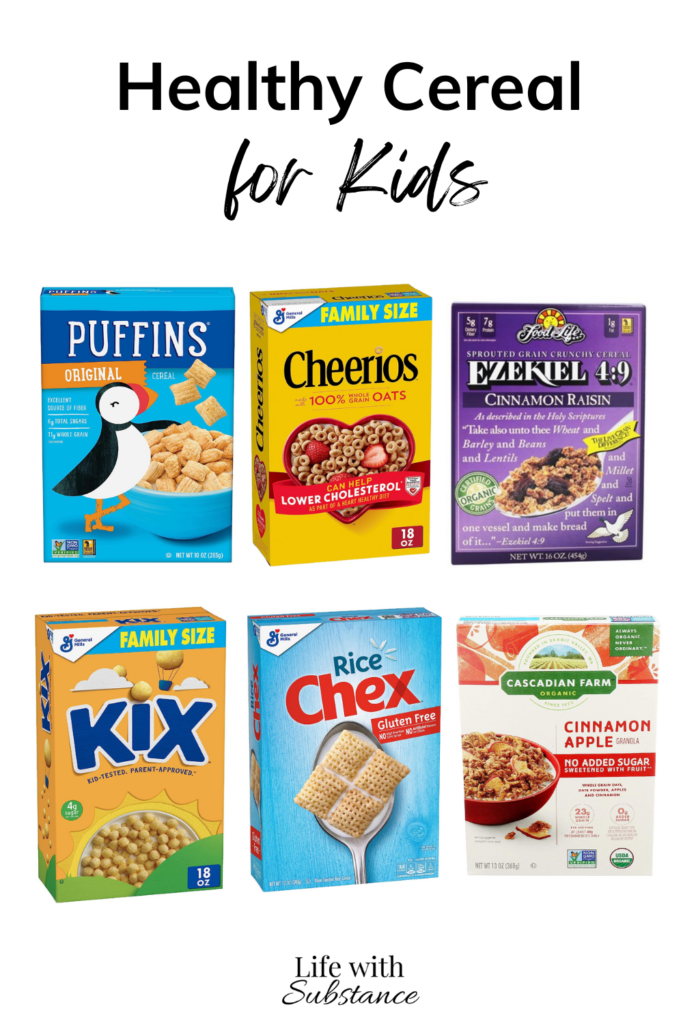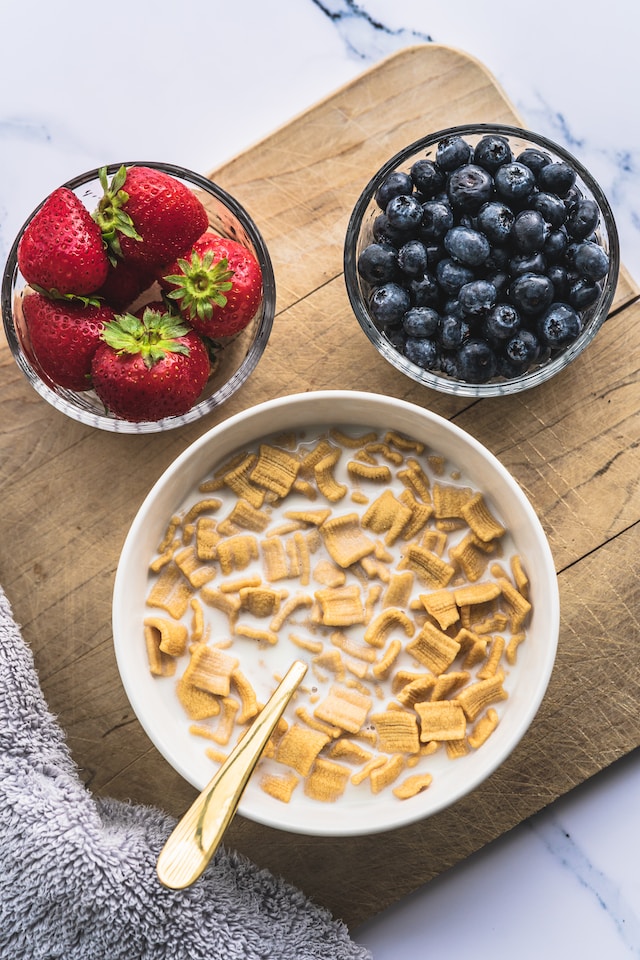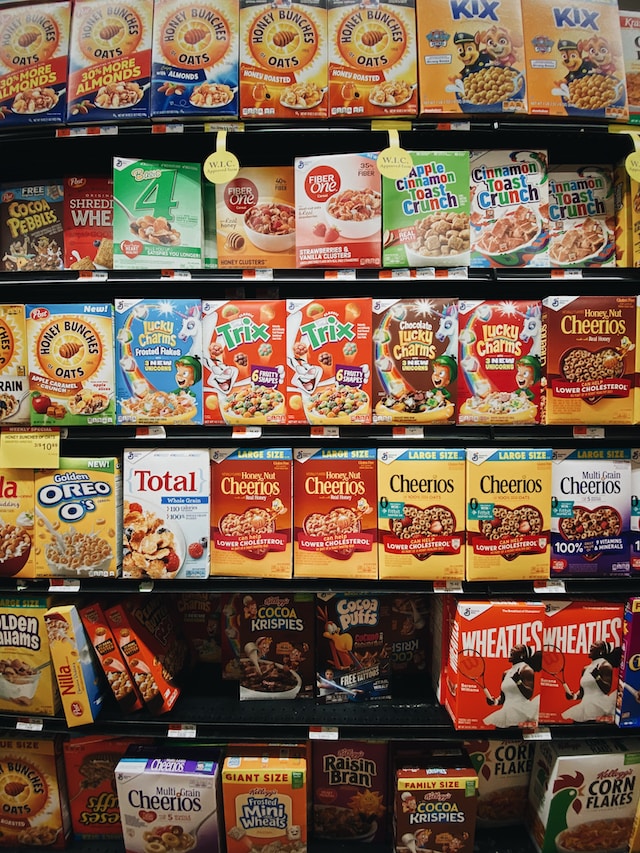This post may contain affiliate links. If you shop from one of our links, we may earn a commission.
The cereal aisle is confusing at best with its huge assortment of cereals to choose from all claiming they’re the most healthy cereal for kids. Kids’ cereals have gotten a bad rap over the years by people stating it’s an “unhealthy breakfast option” or an “incomplete meal”. But what I have come to find out is that there are lots of great cereal options. So let’s clear up the confusion on how to pick out the best cereal for your child. In this post, I’ll fill you in on how to quickly read a nutrition label to determine if that cereal is a healthier option for your family. Because I get it, you likely are in the store with kids trying to ask for multiple items to throw in the cart while you’re trying to figure out the best cereal option.
Picking Out A Healthy Cereal for Kids
Cereal was always a staple breakfast option in my home growing up. So naturally, I always have a couple of boxes on hand for my kids as well when we need a quick and easy breakfast for busy mornings, a great dry snack mix, or for use in recipes. But here are some things to look for when choosing the best option for your family.

Added Sugars
When you grab a box of cereal off the shelf and look at the nutrition label, the first thing to observe is the sugar content. Let’s talk for a minute about added sugars. I’m not referring to sugar that is naturally occurring in food such as fruit or dairy products. I’m talking about sugar that has been added to the product in order to sweeten it with different names such as sucrose, dextrose, brown sugar, agave, honey, syrups, and juices, to name a few.
The Dietary Guidelines for Americans (2020-2025) discovered that toddlers in the United States are consuming more than 100 calories per day from added sugars. They found about 25% of added sugars come from sugar-sweetened beverages, such as fruit juices, and 15% comes from bakery items. The American Heart Association recommends kids under 2 should avoid all added sugars. Over the age of 2 limit added sugars to 25 grams (6 teaspoons) per day. Keep in mind that 4 grams of sugar is equivalent to 1 teaspoon.
Now hear me out, I think sugar-sweetened items should be enjoyed and offered. Placing restrictions around these items makes them highly coveted and more desired. We are also sending the message that these are “bad” foods, causing negative food relationships. However, we can be cautious about how frequently they are offered or choosing lower sugar options.
The nutrition facts label has been updated in the past several years to include a section for “added sugars”. This can help you to differentiate how much sugar is naturally occurring versus how much has been added per serving. When looking at the nutrition label, aim for 0-6 grams of added sugar per serving.
However, there are cereals out there that contain around 9 grams of added sugar, but they are a great source of fiber, protein, and whole grains and I would still offer them as a good option. Because, let’s be real, kids are generally looking for the “fun” cereal with cute cartoon characters rather than Bran Flakes. And sometimes we are better off serving the slightly higher sugar option that still checks the other boxes.
Transitioning to Lower Sugar Options
If you have been choosing cereals that are higher in sugar, your kids may complain that these low-sugar cereals are more plain or bland. Here are some options to help sweeten their cereal as you transition.
– Sprinkle a little confectioner’s sugar on top. While this still adds sugar to the cereal, a small sprinkling on top is still less sugar than what they are likely consuming in their higher sugar option currently.
– Add fresh fruit such as sliced strawberries, bananas, or blueberries to the cereal for a natural sweetener.
– Mix cereals half and half. For example, if they are used to Honey Nut Cheerios and you are transitioning to plain Cheerios, mix them together in equal parts.
Whole Grains
The next qualifier to look for on the label is if the first ingredient on the ingredient list in the product states it contains whole grains. If the front of the cereal box states it contains whole grains it means that half of the grains in the cereal come from whole grains. If the product states it is made with 100% whole grains, then all the grains used in the product are whole grains.
Protein and Fiber
The next thing to look for on the nutrition label is the amount of protein and fiber the cereal contains. The goal is at least 2 grams of protein and 2 grams of fiber per serving. Protein and fiber are both important nutrients for decreasing blood sugar spikes and helping to satisfy their appetite.
Cereal as Part of a Balanced Meal
Some people may debate that cereal is not a good choice for breakfast. However, cereal can provide a good source of vitamins, protein, fiber, and whole grains. Here are some ways to boost the nutritional value of cereal for breakfast.
Serve with Milk
To help make their breakfast more satisfying, serve it with milk or a milk alternative. If you have little ones who are over a year old, use a small amount of milk in the cereal and let it soak for a bit. This helps soften the cereal for chewing and swallowing while making it easier to use their hands as they likely aren’t using silverware yet. If your child prefers dry cereal, offer a glass of milk or a milk alternative on the side. Cereal can also be added to yogurt for a fun twist on a parfait.
Pair with Fruit
Serve with a side of fruit to help balance out the meal. You may also add fruit to the cereal if your child likes it that way. Adding fruit is a great way to enhance their intake of vitamins, minerals, and fiber.

High-Fiber Breakfast Cereal for Constipated Kids
Cereal can be an excellent way to help kids who are struggling with constipation. The recommendation for kids ages 1-3 is 19 grams of fiber per day, and 25 grams for kids 4-8 years old. Shredded wheat cereals generally contain around 4 grams of fiber per serving, making them a good high-fiber option. Bran cereals are also a great option, however, check the labels to ensure the sugar content isn’t too high. You can also sprinkle Tiny Sprouts (Code: CHRISTINE10) on their cereal for an easy way to provide a good source of fiber and other nutrients.
Be Aware of Advertising
Companies, of course, want you to purchase their products. And because they know that most moms value their child’s nutrition, they are going to make the box appear like theirs is a healthy option. Just because they have claims such as “natural ingredients”, “gluten-free”, or “no preservatives” doesn’t mean they are automatically healthy options. I encourage you to look past the pretty packaging to discover the more important details on the nutrition labels. That’s where you will find the real facts about your product.

Healthy Cereal Options for Kids (and Adults)
I did include a few slightly higher sugar content options just because they provide a source of protein and fiber, and as parents, we still want to find some options that our kids will enjoy. The nutrition information provided is based on the recommended serving size, so if your child wants more, obviously the nutrition information will change.
Disclosure: The items listed contain accurate nutrition information at this time. However, this may change over time.
Barbara’s Puffins Original (6 grams added sugar, 6 grams fiber, 3 grams protein)
Barbara’s Multigrain Spoonfuls (5 grams added sugar, 7 grams fiber, 5 grams protein)
Kashi Honey Toasted Oat Cereal (6 grams added sugar, 5 grams fiber, 4 grams protein)
Kashi Organic Warm Cinnamon Oat Cereal (6 grams added sugar, 5 grams fiber, 4 grams protein)
Post Shredded Wheat (0 grams added sugar, 8 grams fiber, 7 grams protein)
Cheerios (1 gram added sugar, 4 grams fiber, 5 grams protein)
Kix (4 grams added sugar, 3 grams fiber, 3 grams protein)
Rice Chex (3 grams added sugar, 2 grams fiber, 3 grams protein)
Corn Chex (4 grams added sugar, 2 grams fiber, 3 grams protein)
Wheat Chex (6 grams added sugar, 8 grams fiber, 6 grams protein)
Cascadian Farm No Sugar Added Cinnamon Apple Granola (0 grams added sugar, 5 grams fiber, 5 grams protein)
Cascadian Farm The Farmland Purely O’s (<1 gram added sugar, 4 grams fiber, 4 grams protein)
Ezekiel 4:9 Cinnamon Raisin (1 gram added sugar, 5 grams fiber, 7 grams protein)
Wheaties (5 grams added sugar, 4 grams fiber, 3 grams protein)
Total (5 grams added sugar, 4 grams fiber, 3 grams protein)
Sunrise Crunchy Cinnamon (5 grams added sugar, 3 grams fiber, 2 grams protein)
Heritage Flakes (5 grams added sugar, 7 grams fiber, 5 grams protein)
Mesa Sunrise (4 grams added sugar, 4 grams fiber, 4 grams protein)
Nature’s Path Crispy Rice (2 grams added sugar, 2 grams fiber, 2 grams protein)
Mom’s Best Toasted Wheatfuls (0 grams added sugar, 8 grams fiber, 7 grams protein)
Uncle Sam Wheat Berry Flakes (1 gram added sugar, 11 grams fiber, 9 grams protein)
Three Wishes Cinnamon, Fruity, and Honey cereals (3 grams added sugar, 3 grams fiber, 8 grams protein)
Three Wishes Cocoa and Frosty cereals (3 grams added sugar, 4 grams fiber, 8 grams protein)
Slightly higher sugar content options:
Kashi Go Coconut Almond Crunch (7 grams added sugar, 6 grams fiber, 10 grams protein)
Mom’s Best Raisin Bran Cereal (8 grams added sugar, 8 grams fiber, 5 grams protein)
Quaker Oatmeal Squares – brown sugar and cinnamon (9 grams added sugar, 5 grams fiber, 6 grams protein)
Kashi Maple Waffle Crisp (8 grams added sugar, 4 grams fiber, 3 grams protein)
Kellogg Raisin Bran (9 grams added sugar, 7 grams fiber, 5 grams protein)
Cascadian Farms Multigrain Squares (9 grams added sugar, 5 grams fiber, 6 grams protein)
General Mills Multigrain Cheerios (8 grams added sugar, 3 grams fiber, 3 grams protein)
Cereal Options for Infants and Toddlers
As I mentioned above, the American Heart Association recommends children under the age of 2 avoid all added sugar. That can make feeding cereal to little ones particularly tricky. However, there are still some options you can offer your child. When your child is developmentally ready for solids, consider infant rice or whole grain cereal, or oatmeal. Around 6 months of age your baby’s iron stores have been depleted and require supplemental iron from food, such as cereal. If you are concerned about heavy metals, aim for oat-based baby cereal instead of rice.
If you don’t want to purchase the infant oatmeal, you can put the oats in the blender until they are a fine powder. Mix with warm water or breastmilk. Adding various fruit purees is a great option to help your baby enhance their flavor palate and boost their nutrition profile. If you are ready to introduce allergens, consider mixing in a small serving of peanut butter with the oatmeal. You can read more about introducing allergens here.
Ultimate Cereal Guide
I realize reading labels while shopping with kids is multi-tasking at its finest. That’s why I did the work for you and created the ultimate cereal guide for quick and easy shopping. Throw this in your diaper bag or purse on your next shopping trip to save you the hassle of navigating the cereal aisle with little ones.
In Summary
When trying to choose a healthy cereal for kids, look for these qualifications: 0-6 grams of added sugar per serving, whole grain as the first ingredient, and 2+ grams of protein and fiber. Cereal can still be a healthy option for breakfast. Pair it with milk and a side of fruit for a well-balanced meal. Grab the free cereal guide to help you get started!


